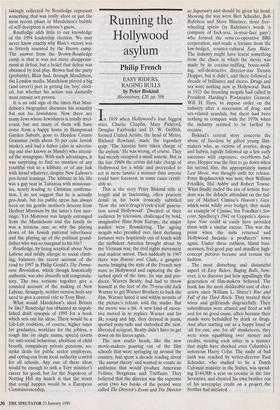Running the Hollywood asylum
Philip French
EASY RIDERS, RAGING BULLS by Peter Biskind Bloomsbury, £20, pp. 506 In 1919 when Hollywood's four biggest stars, Charlie Chaplin, Mary Pickford, Douglas Fairbanks and D. W. Griffith, formed United Artists, the head of Metro, Richard Rowland, made the legendary quip: 'The lunatics have taken charge of the asylum.' He was wrong, of course. They had merely occupied a small annexe. But in the late 1960s the artists did take charge of Hollywood for a while and proceeded to act in more lunatic a manner than anyone could have foreseen, in some cases certifi- ably so.
This is the story Peter Biskind tells at length and in fascinating, often prurient detail in his book ironically subtitled `How the sex'n'drugs'n'rock'n'roll genera- tion saved Hollywood'. Divested of their audience by television, challenged by bold, imaginative films from Europe, the major studios were floundering. The ageing moguls who presided over their declining fortunes were hopelessly out of touch with the turbulent America brought about by the Vietnam war, the civil rights movement and student unrest. Then suddenly in 1967 there was Bonnie and Clyde, a gangster movie bringing the style of the French new wave to Hollywood and capturing the dis- turbed spirit of the time. Its star and pro- ducer, Warren Beatty, had had to throw himself at the feet of the 75-year-old Jack Warner to get Warner Brothers to back the film. Warner hated it and within months of the picture's release sold the studio. But the movie was a hit. A new kind of execu- tive moved in to replace Warner and his ilk; young and hip, they dressed in jeans, sported pony-tails and embodied the new, liberated zeitgeist. Beatty didn't have to get down on his knees again.
The new studio heads, like the new movie-makers pouring out of the film schools that were springing up around the country, had spent a decade reading about `the auteur theory' and wanted to create an ambience that would produce American Fellinis, Bergmans and Truffauts. They believed that the director was the supreme artist (two key books of the period were called The Director's Event and The Director as Superstar) and should be given his head. Showing the way were Bert Scheider, Bob Rafelson and Steve Blautner, three free- wheeling spirits (in Rafelson's words 'a company of fuck-you, in-your-face guys') who formed the semi-co-operative BBS corporation, and made a fortune from the low-budget, counter-cultural Easy Rider. The industry might have learnt something from the chaos in which the movie was made by its cocaine-sniffing, booze-swill- ing, self-destructive director-star Dennis Hopper, but it didn't, and there followed a decade of brilliance and excess. Drugs and sex were nothing new in Hollywood. Back in 1923 the founding moguls had called in President Harding's Postmaster General, Will H. Hays, to impose order on the industry after a succession of drug- and sex-related scandals, but there had been nothing to compare with the 1970s when the industry seemed to be fuelled by cocaine.
Biskind's central story concerns the abuse of freedom by gifted young film- makers who, as victims of avarice, drugs and hubris, rapidly followed up a few early successes with expensive, overblown fail- ures. Hopper was the first to go down when his second film, the appropriately named Last Movie, was thought unfit for release. Peter Bogdanovich was next, then William Friedkin, Hal Ashby and Robert Towne. What finally ended the era of artistic free- dom was the debacle attendant on the fail- ure of Michael Cimino's Heaven's Gate, which went wildly over budget; they made an example of Cimino, but Friedkin's Sor- cerer, Spielberg's 1941 or Coppola's Apoca- lypse Now could as easily have provided them with a similar excuse. This was the point when the suits returned and Hollywood became a producers' town again. Under these ruthless, bland busi- nessmen, feel-good pap and mindless high- concept pictures became and remain the fashion.
The most disturbing and distasteful aspect of Easy Riders, Raging Bulls, how- ever, is to discover just how appallingly this generation of film-makers behaved. The book has the most dislikeable cast of char- acters since William L. Shirer's Rise and Fall of the Third Reich. They treated their wives and girlfriends disgracefully. Their subordinates were abused and fired at will and for no good cause, often because their minds were befuddled by drink or drugs. And after starting out as a happy band of `all for one, one for all' musketeers, they were soon squabbling over money and credits, treating each other in a manner that might have shocked even Columbia's notorious Harry Cohn. The nadir of bad faith was reached by writer-director Paul Schrader, who studied to be a Dutch Calvinist minister in the Sixties, was spend- ing $144,000 a year on cocaine in the late Seventies, and cheated his own brother out of his screenplay credit on a project the brother had initiated.


























































 Previous page
Previous page